Abstract
In the context of ecological civilization construction in China, interregional ancient trees are important natural and cultural resources, and it is vital that they are effectively protected and utilized according to their spatial distribution and regional conditions in order to provide a balance between local economic development and the ecological environment. This article analyzes the spatial heterogeneity of 26,842 ancient trees and explores the underlying natural and human factors by using geoinformatics–based techniques (i.e., the nearest neighbor index, kernel density, spatial autocorrelation, and the geographically weighted regression model) in Henan Province, Central China. The research findings conclude that: (1) The interregional ancient trees show positive spatial autocorrelation, and the aggregation effect in Western Henan is the most significant. (2) The growing environment and elevation exert a more obvious influence on the spatial pattern of interregional ancient trees. (3) The main influencing factors per region are different, for example, historical culture in Western Henan, water source and elevation in Southern Henan, and the growing environment in Eastern Henan, while ancient trees in Northern Henan have a weak relationship with each factor. This research facilitates political strategy making for sustainable development and the protection of interregional ancient trees.
1. Introduction
Human–nature harmonious coexistence is gradually becoming a major strategy in ecological civilization construction and the ideal of building a “beautiful China”, alongside the transformation and reconstruction of the global economy [1,2]. Ancient trees have received worldwide attention due to their considerable contribution to biodiversity conservation, forest restoration efforts, human societies, and cultures [3,4]. Protecting ancient tree resources plays a vital role in human–nature harmonious coexistence according to local conditions [5]. Firstly, during their extreme longevity, ancient trees have undergone a strong selection process both in natural and built environments. As a result, they retain valuable genes of endangered species, which play a key role in genomic diversity and adaptive capacity over centennial environmental cycles [6,7,8]. Secondly, ancient trees have created many benefits at the ecosystem level. As an important part of the ecosystem, ancient trees are a unique habitat for the conservation of threatened species [9,10] because they can affect ecological factors such as temperature, humidity, and soil quality to resist and buffer climate warming [11,12,13]. Thirdly, ancient trees are equally important to human production and life due to their provision of specific materials for human beings. The leaves, flowers, fruits, seeds, skins, and branches of some ancient trees are important materials for traditional medicine and food in China. For example, Ginkgo offers multiple economic values and vernacular uses. The edible nuts, rich in nutritional value, have been enlisted in various dishes and desserts [14]. Additionally, the leaves and seeds are used in traditional Chinese medicine to treat diseases such as cough and asthma [15]. Fourthly, ancient trees serve as important material carriers to display and inherit local culture. They have typical landscape value due to their unique trunks, branches, and leaves [16,17], as well as them being endowed with certain religious and folklore connotations in special sites, such as temples, ancestral halls, and villages, to load certain emotions of local people [18,19,20]. Despite these benefits, ancient trees are a slowly emerging property of nature and humans and require many centuries to generate [21]; therefore, their unique benefits cannot be recovered without an extensive passage of time. During these decades, ancient trees have declined at an alarming rate in many parts of the world, which is attributed to urbanization, agricultural intensification, and a lack of planting, management, and awareness of the development of ancient tree populations [22,23]. Central China, with many ancient trees, is undergoing a phase of rapid urbanization, which has had a remarkable effect on the original living environment and distribution of ancient trees. Based on the above, ancient trees provide insights into a local human–nature relationship, and that the natural environment (e.g., topography, hydrology, and vegetation) and social factors (e.g., history, culture, and human activities) have a marked impact on ancient trees and their spatial distribution [24,25]. Therefore, this paper will provide an important reference for the protection of ancient trees through studying the spatial pattern of ancient trees and their influencing factors based on the human–land relationship using a geoinformatics-based approach.
Due to the comprehensive characteristics of ancient tree resources, the current research mainly involves the definition and evaluation criteria of ancient trees [26,27], pest control rehabilitation of specific species, etc. [28,29]. Scholars have also researched the excavation of culture and landscape connotations involved in ancient trees [30,31]. Given that the survey of ancient tree resources has successively been carried out across these years, research on the spatiality of ancient trees and the underlying influencing factors has gradually increased [3,16,26]. In recent years, many statistical techniques have been developed to probe into spatial variations in the relationships between spatial variables in the fields of geo-statistics and spatial modeling [32,33]. Geographically weighted regression (GWR), as one of the most powerful geoinformatics–based tools for exploring spatial heterogeneity, has been more widely used in geography, ecology, forestry, and other disciplines [34,35]. GWR is an extension of the traditional regression analysis method for local rather than global parameter estimation, which takes the spatial structure of the data into account in the model, so that the regression coefficients become a function of the geographic location of the observation points, then solves this spatial non-smoothness problem [36].
Existing studies show that there are regional differences and scale effects in terms of the impact of natural and social factors on ancient trees [24,31,37,38]. On the one hand, in terms of regional differences, previous research has mainly focused on the number and species of ancient trees in different regions based on simple mathematical statistics and then explored the influencing factors of distribution qualitatively, or conducted quantitative linear regression analysis [5,24,32,33]. The existing studies focus on the excavation of the factors associated with the ancient trees, while less consideration is given to the influence degree and spatial heterogeneity of the factors influencing the ancient trees. On the other hand, in terms of research scale, the existing research is mostly conducted on a single study area [5,25,39], which makes the ancient tree resources lack certain comparability between the different regions [40]. However, based on the traditional ecological species–area hypothesis, ancient trees and their factors in the area of administrative regions or cities are quite different, resulting in deviation. Furthermore, some research scales are small or medium based on the available ancient tree data, such as for one city or one county [41,42]. Due to the area limitations of the cities and counties where the latitude and longitude spans are small, the differences in internal topography, climate, history and culture, and other conditions are not significant, so it is challenging to distinguish the main drivers of ancient trees in different regions, which is not conducive to the protection of the ancient tree resources in accordance with the local conditions.
In the context of ecological civilization construction and the ideal of building a “beautiful China”, this study focuses on researching the ancient trees in Henan Province in Central China, which has rich ancient tree resources with significant spatial variation. Geoinformatics–based techniques (i.e., the nearest neighbor index, kernel density, spatial autocorrelation, and the geographically weighted regression model) are used to explore the basic distribution pattern, influencing factors, and interregional differences. The aims of this study are as follows: (1) to identify the spatial distribution characteristics of ancient trees; (2) to reveal the influence degree of six natural and human factors on the spatial distribution of ancient trees; and (3) to demonstrate the spatial heterogeneity of six natural and human factors on the spatial distribution of ancient trees. The findings could contribute to the conservation and management of the sustainability of ancient tree resources according to local conditions.
2. Data and Method
2.1. Study Area
Henan Province (31°23′–6°22′ N, 110°21′–116°39′ E) is located in the central part of China (Figure 1), with a total area of about 167,000 km2. In terms of topography, Henan is in the transition zone between the second and third terraces in China’s topography in the east–west direction. Henan Province is surrounded by four main mountains in the north, west, and south with the west high and the east low. The central and eastern regions are made up of the vast Huang–Huai–Hai alluvial plain. In terms of climate, Henan Province belongs to the continental monsoon climate transiting from the north subtropical zone to the warm temperate zone in the north–south direction. In addition, Henan Province has a long history and culture. As the source of Chinese history and civilization, it has been the country’s political, economic, and cultural center for more than 3000 years. A diversified natural environment and profound historical and cultural deposits created rich ancient tree resources in Henan Province. Therefore, it is of great significance to study the ancient tree resources from the interregional perspective in Henan Province.
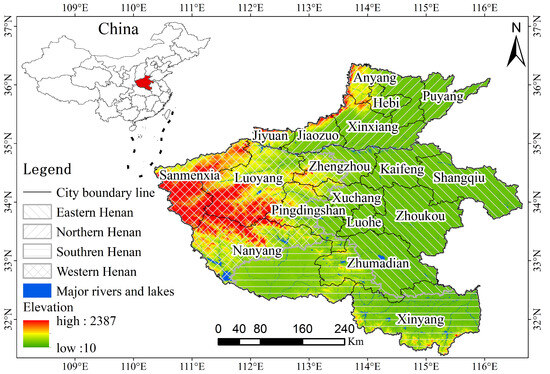
Figure 1.
Study site—Henan Province in Central China.
Given that the interregional disparity in Henan Province is significant, this study divides Henan Province into four regions based on climate and terrain factors, namely Northern Henan, Western Henan, Southern Henan, and Eastern Henan. Northern Henan is mainly located in the Taihang Mountain and the northern Huang–Huai–Hai plain area including Anyang City, Puyang City, Jiaozuo City, Xinxiang City, Hebi City, and JiYuan City to the north of the Yellow River. Western Henan is mainly located in the Funiu mountain area, including Luoyang City, Sanmenxia City, and a part of Zhengzhou City to the south of the Yellow River. Southern Henan is in the Nanyang Basin and Tongbai–Dabie Mountain area to the south of the Huaihe River. Eastern Henan is mainly in the Huang-Huai–Hai Plain area including a part of Zhengzhou City, Kaifeng City, Shangqiu City, and Zhoukou City to the south of the Yellow River, specifically shown in Figure 1.
A total of 26,842 single ancient trees have been identified in Henan Province with a density of 16.20 × 10−2 Plant/km2, belonging to 322 species and 146 genera in 59 families. The number of ancient trees in Western Henan is the largest among all regions, with 16,475 ancient trees, accounting for 61.38% of all in Henan Province, and the density is also the largest, which is 34.22 × 10−2 Plant/km2. There are 3999 ancient trees in Northern Henan accounting for 14.89%, and the density is 14.28 × 10−2 Plant/km2. The number of ancient trees in Southern Henan is 3679 accounting for 13.71%, and the density is 10.08 × 10−2 Plant/km2. The number of ancient trees in Eastern Henan is the least, with 2689 trees accounting for 10.02%, and the density is also the smallest, 5.07 × 10−2 Plant/km2.
2.2. Indicator System and Data Source
This study aims to describe the spatial distribution of ancient trees and the influencing factors by geoinformatics–based methods. The dependent variable is the number of ancient trees for each town, and 1586 towns with ancient trees in four regions of Henan Province are taken as research units. Many variables are tested, and six natural and human factors (Figure 2) are selected as the independent factors in terms of the representativeness of the indicators, the actual situation of Henan Province, and data redundancy. In natural factors, elevation and slope are the common factors representing terrain [3,16,25]. Precipitation and temperature data tend to result in less variation for townships in the same region [15,25], so the closest distance from ancient trees to rivers and lakes is used to quantify the water source. In human factors, the ratio of forest and orchard land area is used to explain the habitats of ancient trees [26]. The long history of Henan Province has left extremely valuable and rich cultural relics, and ancient trees are an important part of historical and cultural resources, so it is necessary to explore the relationship between them [16,26]. POIs (points of interest) are selected to interpret the intensity of human and economic activity. Compared to other factors, such as population density, distance from the city center, building density, and gross domestic product, POIs are comprehensive spatial data and do not involve the issue of statistical caliber, which fits with the purpose of this study to identify the main factor of the spatial distribution of ancient trees by a geoinformatics–based approach [43,44]. The quantification standard of each influencing factor is shown in Table 1. The basic statistics of the variables are listed in Table 2. Additionally, the results of the OLS model show that the variance inflation factors (VIFs) of six explanatory variables in Henan Province and four regions are in the range [1.009, 2.578] (Table 3), and the VIF values are all less than 7.5, so there are no redundant explanatory variables.
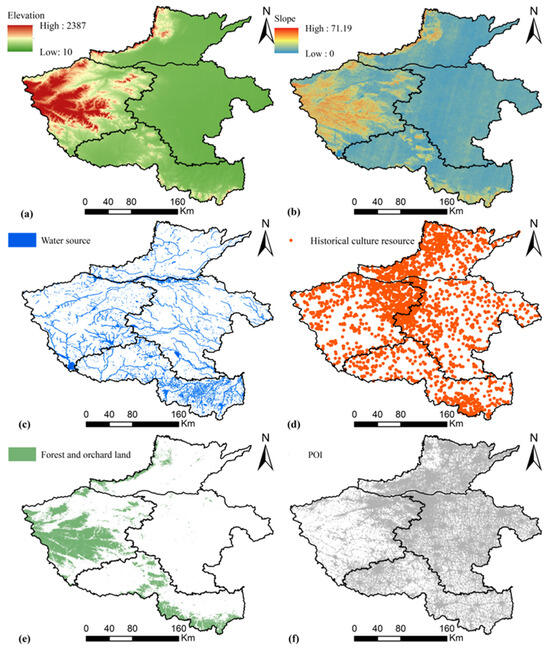
Figure 2.
Influencing factors of ancient trees in Henan: (a) elevation; (b) slope; (c) water source; (d) historical culture resource; (e) forest and orchard land; (f) POIs.

Table 1.
Quantification standard of influencing factors.

Table 2.
Descriptive statistics of influencing factors in this study.

Table 3.
The VIFs of all explanatory variables in the OLS model.
The spatial information of ancient trees in Henan Province is acquired from the Cloud platform for forest genetic resource information of Henan Province (2017–2020), and the types, ages, and locations of ancient trees are reviewed and corrected. The slope and elevation data are from the 30 m resolution data of the Digital Elevation Model (DEM). Rivers and land use data are extracted from the remote sensing monitoring data of land use status in Henan Province in 2020. The DEM and land use data are provided by the Resource and Environment Science and Data Platform of the Chinese Academy of Sciences (https://www.resdc.cn/) (accessed on 8 August 2023). Historical and cultural resources include the national and provincial lists of important heritage conservation units, historical and cultural famous villages, towns and cities, and traditional villages in Henan Province, which are collected from Henan Provincial Administration of Cultural Heritage (https://wwj.henan.gov.cn/) (accessed on 16 August 2023). The Gaode map API (Application Programming Interface) tool (https://lbs.amap.com/) (accessed on 24 August 2023) is used to obtain the latitude and longitude coordinates of historical–cultural resources and POIs, and the latitude and longitude coordinates are verified to ensure that the coordinates of the same spot in multiple lists are consistent and not duplicated. As a result, there are 3,695,857 POIs and 3759 historical and cultural resource spots adopted in this study.
2.3. Methods
2.3.1. Nearest Neighbor Index (NNI)
The NNI is defined as the ratio of the actual nearest neighbor distance to the theoretical nearest neighbor distance [45]. In general, NNI > 1 indicates that the ancient trees are uniformly distributed, NNI = 1 indicates random distribution, and NNI < 1 indicates agglomerative distribution. The smaller the NNI value, the more agglomerated ancient trees are distributed, which is calculated as follows:
where dij is the actual distance between two ancient trees, A refers to the total area of Henan Province, and n is the number of ancient trees.
2.3.2. Kernel Density Estimation (KDE)
The KDE method uses the density function to depict the distribution pattern and evolution trend of random variables [46]. It is used to describe the density pattern of ancient trees in Henan Province with the help of a moving cell and obtain the diagram of the continuous change in their density, to represent the agglomeration and diffusion characteristics of the ancient trees.
where is the kernel function, and h > 0 is the bandwidth, represents the distance from x to event . A larger value indicates denser ancient trees and a higher occurrence probability.
2.3.3. Global Moran’s I Index
Global Moran’s I index can be used to observe the spatial correlation of ancient trees in the whole study area based on their spatial locations [47]. The specific calculation formula is as follows:
where n is the number of ancient trees, and Xi and Xj, respectively, represent the ancient trees in the ith and jth units. is the mean value of ancient trees, Wij is the spatial weight matrix, and S0 is the sum of the spatial weight matrix. The value of Moran’s I ranges from −1 to 1. Moran’s I > 0 indicates a positive spatial correlation, whereas Moran’s I < 0 indicates a negative spatial correlation. If the index is close to 0, then no spatial correlation is observed.
2.3.4. Geographically Weighted Regression (GWR)
The GWR model is proposed to effectively reflect the spatial non-stationarity of characteristics in regression relationships [48]. As a local parameter estimation method, the GWR model assigns a regression coefficient to each spatial position, which is unattainable using the ordinary least squares (OLS) model. The GWR model can be interpreted as follows: A continuous decay function is calculated based on the spatial distance of the element locations in a given spatial region. The weight of each element in the local regression equation is then calculated to obtain the weighted regression equation. The Akaike information criterion (AIC) method is based on the concept of entropy and can be obtained. Thus, in this study, the AIC is used to optimize the bandwidth. The model is defined in Equation (4):
where yi is the number of ancient trees in the ith units, xik refers to the (n × k)-dimensional explanatory variable matrix, βk(ui, vi) is the regression coefficient of factor k at regression point I, n refers to the number of independent variables, (ui, vi) refers to the longitude and latitude coordinates of the ith observation point, and εi is the residual.
2.4. Study Steps
The study steps are as follows: (1) regional division: Henan Province is divided into four regions based on climate and terrain factors at the township spatial scale; (2) spatial distribution pattern analysis: NNI and KDE are used to reveal the basic distribution pattern of ancient trees in Henan Province, then Global Moran’s I is used to compare the spatial correlation of ancient trees in different regions; (3) model assessment: AICc and R2 are used as the indicators to evaluate OLS and GWR in terms of identifying factors of ancient trees; and (4) influencing mechanism investigation: GWR is used to demonstrate the influence degree and spatial heterogeneity of six natural and human factors on the spatial distribution of ancient trees in different regions. Relevant statistics and taxonomy of ancient trees are performed in the software Excel 2019. Regional division, data preprocessing, and model building are performed in the software ArcGIS 10.8.
3. Results
3.1. Spatial Variation and Correlation of Ancient Trees
The average observed distance is 469.03 m among ancient trees in Henan Province, while the average expected distance is 1673.89 m, and the NNI is 0.28 (<1). According to standardized statistics, the Z-value is 225.60 m, the p-value is 0 (p < 0.01), and the confidence is 99%, indicating that the spatial distribution of ancient trees in Henan Province is agminated. In different regions, the NNI is less than 1. The most significant aggregation is in Western Henan with an NNI of 0.28, followed by Northern Henan with 0.29. Ancient trees are relatively scattered in Southern Henan and Eastern Henan, resulting in NNIs of 0.35 and 0.39, respectively.
The KDE results of ancient trees in Henan Province are spatialized in Figure 3. Ancient trees in Henan Province are mainly concentrated in the Funiu Mountain and Songshan Mountain areas in Western Henan, and the Dabie Mountain area in Southern Henan. Ancient trees in Northern Henan are mainly concentrated in the Wangwu Mountain and Taihang Mountain areas. Ancient trees in Eastern Henan are relatively scattered, mainly concentrated in areas with rich tourism resources, such as Nanjiecun Village in Luohe City and the Taihao Fuxiling Mausoleum Cultural Tourism Area in Zhoukou City.
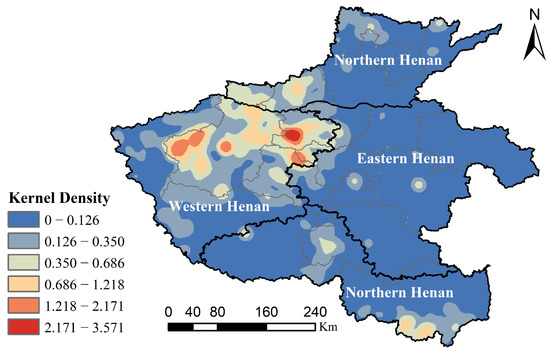
Figure 3.
The map of ancient tree kernel density estimation in Henan.
The distribution of interregional ancient trees shows positive spatial autocorrelation in Henan Province. The result of Global Moran’s I of ancient trees in Henan Province is 0.2694 > 0, and the Z-value is 21.23, passing the 99% confidence test. The space autocorrelation of ancient trees in Southern Henan is the most significant, and the result of Global Moran’s I is 0.3803, followed by Western Henan where the Moran’s I is 0.2573. The spatial correlation degree of ancient trees in Northern Henan is relatively weak, and that in Eastern Henan is the weakest, resulting in Moran’s Is of 0.1164 and 0.0991, respectively. The ancient trees are mainly scattered in Eastern Henan and have a continuous distribution only on the border with Western Henan. Most of the towns with more ancient trees have neighbors with fewer ancient trees in Eastern Henan.
3.2. Influencing Mechanism Investigation
The results of the GWR model are compared with those of the OLS model to explore the influencing factors and their spatial variation in Henan Province. As shown in Table 4, the R2 and adjusted R2 of GWR are 0.525 and 0.406, respectively, while those of OLS are 0.189 and 0.186. The AICc value (−4076.4359) in the GWR is much smaller than that in the OLS model (−3763.839), and the model condition values in the GWR are all smaller than 30, indicating that collinearity is not present. The comparison results of the two models in different regions show a similar rule to that of Henan Province. In conclusion, compared with OLS, the GWR model is more scientific and applicable to analyzing the factors affecting the spatial heterogeneity of interregional ancient trees in Henan Province.

Table 4.
Model analysis and comparison.
The regression coefficients of the selected driving factors calculated by the GWR model are shown in Table 5. The signs of the maximum and minimum values of the regression coefficients for all the variables are different. This indicates that the various influencing factors on the spatial distribution of ancient trees in Henan Province and its four inter-regions are complex. Based on the comparison of all regression coefficient means, elevation, slope, water source, historical culture, and growth environment are positively correlated with the spatial distribution of ancient trees, while human activity intensity is a negative factor. The above variables are ranked as follows: growth environment > elevation > historical culture > slope > human activity intensity > water source.

Table 5.
Statistics of influencing factor regression coefficients in the GWR model.
3.3. Specific Explanations of Influencing Factors
3.3.1. Elevation
The elevation in Henan Province is divided into mountain (>500 m), hill (200–500 m), and plain (<200 m). The numbers of ancient trees are 9994 (37.23%), 8883 (33.09%), and 7965 (29.67%), respectively. The regression coefficient of elevation factor is 2.293–3.104 and the mean is 0.238. In general, elevation has a positive correlation with the distribution of ancient trees, but negative correlations are found in the Funiu Mountain, Xiong’er Mountain, Xiao Mountain, and other mountainous areas, as well as the plain area including Puyang City, Shangqiu City, and Zhoukou City (Figure 4). The effect of elevation on the distribution of interregional ancient trees is similar to that in Henan Province, with the average regression coefficients of 0.087 (Northern Henan), 0.363 (Western Henan), 0.771 (Southern Henan) and 0.042 (Eastern Henan), respectively. This shows that the overall correlation is positive. The effect in Southern Henan is the most significant, where there is only a negative correlation in Xindian Town in Xinye County, while others show a positive correlation with high regression coefficients in the Dabie Mountain area. The second regression coefficient of the elevation factor is in Western Henan with a significant high correlation in low mountains and hilly areas around Song Mountain. The regression coefficient in Northern Henan is generally low, but mostly shows a positive correlation, with only a few flat regions (e.g., Fan County and Taiqian County in Puyang City). In Eastern Henan, the high regression coefficients are mainly concentrated in the west and south near the hilly regions.
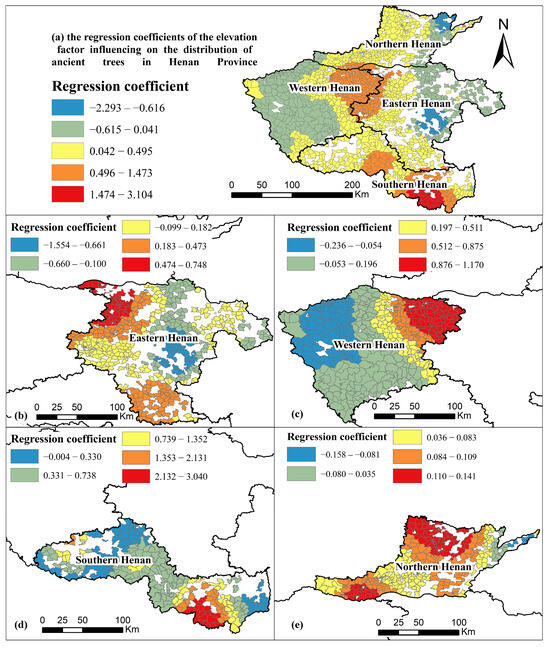
Figure 4.
Spatial heterogeneity of elevation and ancient trees: (a) Henan Province; (b) Eastern Henan; (c) Western Henan; (d) Southern Henan; (e) Northern Henan.
3.3.2. Slope
In Henan Province, 14,231 (53.02%) ancient trees are distributed on gentle slopes (5°–15°), followed by flat slopes (0°–5°, 8923, 33.24%). In areas with a slope > 5, the number of ancient trees decreases sharply; there are only 16 ancient trees in the areas with a slope >45. The regression coefficient of the slope variable is −0.453–0.806 (Figure 5), with a mean of 0.019 and a standard deviation of 0.161. Therefore, there is almost a positive and weak correlation between the slope factor and the spatial distribution of ancient trees in Henan Province. The positive regression coefficients are in the Funiu Mountain area, while the negative regression coefficients are concentrated around Song Mountain. The average regression coefficient (0.065) in Western Henan is the highest, and the area with a positive regression coefficient is relatively large and mainly concentrated in Funiu Mountain and its surrounding areas. Meanwhile, a small number of areas show a negative correlation in the northeastern corner of Western Henan. The average regression coefficient in Southern Henan is 0.006, and the positive regression coefficients are mainly concentrated in Dabie Mountain in Xinyang City, while the area with significant negative correlation is mainly located in Nanyang Basin. The average regression coefficient in Northern Henan is 0.005. The positive regression coefficients are in gentle slope areas near the Yellow River, while the negative correlation regression coefficients are mainly distributed near the plain area. The mean regression coefficient in Eastern Henan is the lowest (0.001) with a small standard deviation.
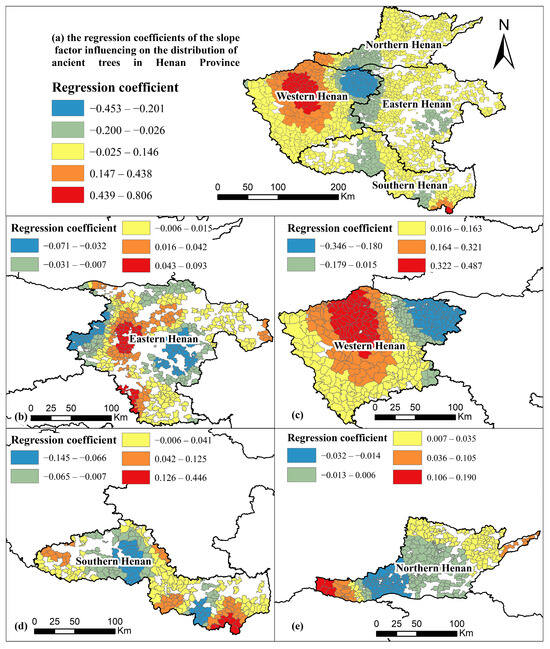
Figure 5.
Spatial heterogeneity of slope and ancient trees: (a) Henan Province; (b) Eastern Henan; (c) Western Henan; (d) Southern Henan; (e) Northern Henan.
3.3.3. Water Source
There are 10,753 (40.06%) ancient trees 0–2 km away from a water source, followed by those within 2–4 km away from a water source (8669, 32.30%), while the number of ancient trees over 6 km away from a water source is significantly reduced (3219, 11.99%). Figure 6 shows that the regression coefficients of water sources are −0.157–0.840, the mean is 0.013, and the standard deviation is 0.074. The regression coefficients of water sources are similar in different regions of Henan Province, and the average regression coefficients are all positive. The influence of water sources in Southern Henan is the most significant (0.058), followed by Western Henan (0.022). The average regression coefficients of water sources in Eastern Henan and Northern Henan are 0.002 and 0.001, respectively. The negative regression coefficients of water sources are mainly concentrated around large water areas, such as Nanwan Reservoir in Southern Henan, Danjiangkou Reservoir in Western Henan, Ying River in Eastern Henan, and Qin River in Southern Henan.
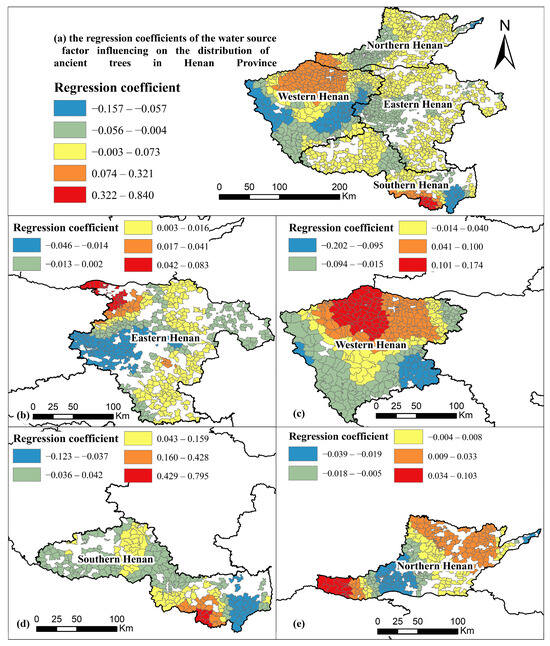
Figure 6.
Spatial heterogeneity of water source and ancient trees: (a) Henan Province; (b) Eastern Henan; (c) Western Henan; (d) Southern Henan; (e) Northern Henan.
3.3.4. Historical Culture Resource
In Henan Province, there are 19,435 ancient trees within 5 km of the nearest historical culture resource, accounting for 72.40%. A total of 10,577 (39.4%) ancient trees are within 2–5 km and 8858 (33%) ancient trees are within 2 km. When the distance is >5 km, the number of ancient trees decreases sharply, with 6015 (22.41%) ancient trees 5–10 km and 1392 (5.19%) more than 10 km from history and culture resources. The regression coefficients of historical culture resource factors on the spatial distribution of ancient trees are from −0.559 to 1.473 with an average value of 0.082, which indicates that the closer the historical culture resources are, the more ancient trees there are (Figure 7).
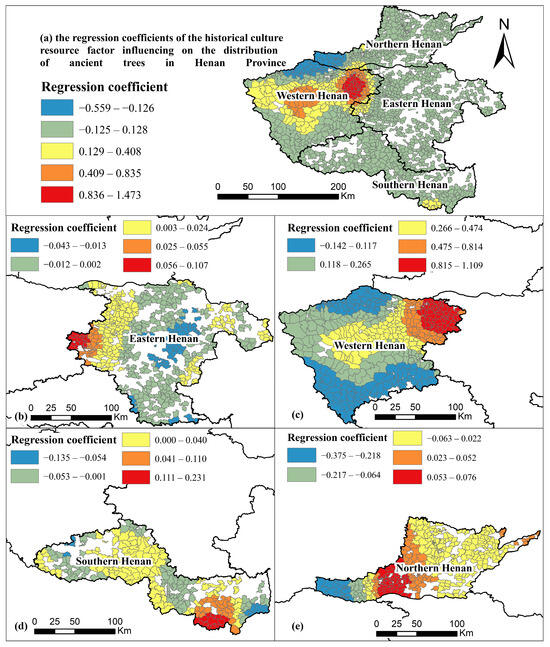
Figure 7.
Spatial heterogeneity of historical culture resources and ancient trees: (a) Henan Province; (b) Eastern Henan; (c) Western Henan; (d) Southern Henan; (e) Northern Henan.
The average regression coefficients in the four regions are all positive, such as 0.356 in Western Henan, 0.012 in Southern Henan, 0.004 in Eastern Henan, and 0.001 in Northern Henan. The historical culture resources have the greatest influence on the distribution of ancient trees in Western Henan. The significant positive correlations are mainly distributed in areas rich in historical and cultural resources, such as the Songshan Mountain area in the west of Zhengzhou City and the Yiluo River basin in Luoyang City in Western Henan, and Xinxian County and Guangshan County in Southern Henan. There are negative correlations between historical culture resources and the spatial distribution of ancient trees in plain areas where ancient trees are scattered and few, far away from historical culture resources.
3.3.5. Growth Environment
The regression coefficients of the growing environment on the distribution of ancient trees in Henan Province range from −6.309–24.642 (Figure 8), with a mean value of 0.323, and a standard deviation of 1.741. Compared with other driving factors, the growing environment factor has the strongest influence on the spatial distribution of ancient trees, and the spatial differences are the most significant. The regression coefficients in the four regions are all positive, such as 1.028 in Eastern Henan, 0.339 in Southern Henan, 0.087 in Northern Henan, and 0.083 in Western Henan. The above data indicate that the ratio of forest and orchard land area has a positive relationship with the distribution of ancient trees in Henan Province and the four regions. Moreover, the high positive regression coefficients are mainly distributed in the area rich in forest and orchard resources, while the negative coefficients mainly exist in the urban districts and their surrounding areas, especially in Kaifeng City and Zhumadian City in Eastern Henan, in Nanyang City and Xinyang City in Southern Henan, in Anyang City and Hebi City in Northern Henan, and Luoyang City in Western Henan.
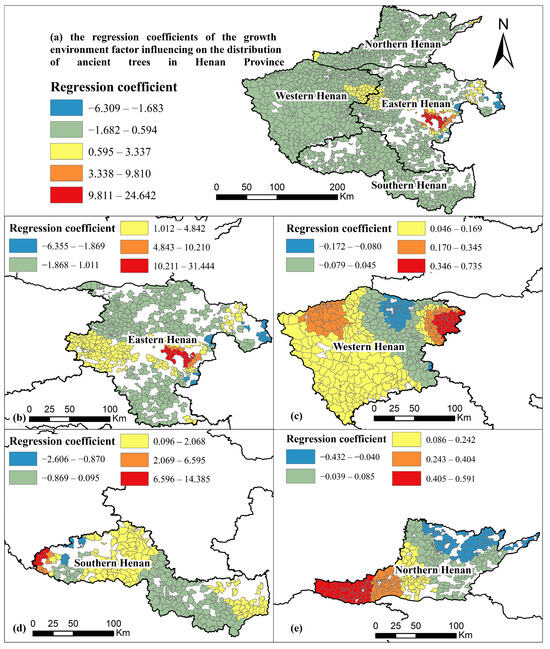
Figure 8.
Spatial heterogeneity of growth environment and ancient trees: (a) Henan Province; (b) Eastern Henan; (c) Western Henan; (d) Southern Henan; (e) Northern Henan.
3.3.6. Human Activity Intensity
The distribution of ancient trees is negatively correlated with human activity intensity. The regression coefficients are −1.776–0.451, with a mean value of −0.019 and a standard deviation of 0.217. The hilly and mountainous regions of Henan Province, which have fewer POIs and more ancient trees, exhibit a negative correlation. Conversely, the areas with a significant positive correlation are primarily located in the densely populated urban areas of the eastern plains (Figure 9).
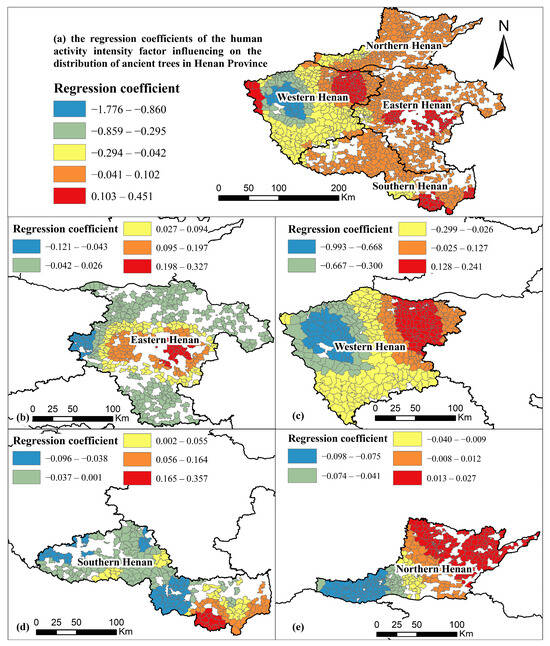
Figure 9.
Spatial heterogeneity of human activity intensity and ancient trees: (a) Henan Province; (b) Eastern Henan; (c) Western Henan; (d) Southern Henan; (e) Northern Henan.
In different regions, human activity intensity is negatively correlated with the ancient tree resources in Western Henan and Northern Henan with average regression coefficients of −0.106 and −0.018, respectively. It is positively correlated in Eastern Henan and Southern Henan with average regression coefficients of 0.039 and 0.008, respectively. The areas with negative regression coefficients are mainly concentrated in the Funiu Mountain area in Western Henan and the Taihang Mountain area in Northern Henan. The regression coefficients are positive in areas concentrated in cities and towns, such as Luoyang City in Western Henan, and Anyang City and Hebi City in Northern Henan. The spatial distribution of ancient trees in most of the areas in Eastern Henan is positively correlated with the number of POIs. The number of POIs in Southern Henan has the least influence on ancient trees. The areas with high positive regression coefficients are mainly located in Shangcheng County and Xinxian County of Xinyang City, while the areas with significant negative correlations are mainly located in Nanyang Basin and Xinyang City.
4. Discussion
4.1. Research Findings
The research findings involve three aspects: (1) identifying the spatial distribution characteristics of ancient trees; (2) revealing the influence degree of six natural and human factors on the spatial distribution of ancient trees; and (3) demonstrating the spatial heterogeneity of six natural and human factors on the spatial distribution of ancient trees.
The ancient trees in Henan Province display the spatial characteristics of aggregation and are mainly concentrated in the Funiu Mountain area in Luoyang City, the Songshan Mountain area in Zhengzhou City in Western Henan, and the Dabie Mountain area in Xinyang City in Southern Henan. This result is consistent with other recent works [49]. The spatial distribution of ancient trees may be affected by natural and human factors. This study uses geoinformatics–based techniques to reveal the influence degree and spatial heterogeneity of six factors based on the “human–land relationship”.
Among the natural factors, elevation has the most significant effect on the spatial distribution of ancient trees, followed by slope and water source. In Henan Province, the correlation coefficient values show positive correlations between elevation and ancient trees in general. The low mountainous and hilly areas with gentle slopes can prevent direct and indirect human interference (e.g., deforestation, arson, etc.), mirroring similar trends observed in Australia [50]. At high elevations (>500 m) and slopes (>15), the number of ancient trees decreases sharply due to limited hydrothermal conditions, possible landslides, and mudflows, which are important for the site environment of ancient trees. The impact of water sources on ancient trees in Henan Province is not significant, which is inconsistent with some research [15]. The reason is probably that the influence of water sources on ancient trees’ distribution has a scale effect. Compared to China as a whole, water sources vary less and have an insignificant effect on the distribution of ancient trees within Henan Province.
In terms of human factors, the growing environment has the most significant influence on the spatial distribution of ancient trees in Henan Province, followed by historical culture resources and human activity intensity. The ratio of forest and orchard land area has an important impact on the abundance of ancient trees in Henan Province; the results of other studies have shown that this is a common phenomenon [26] because forest and orchard land provide stable habitats for the growth and reproduction of ancient trees. Additionally, many forests in Henan Province have been established as national forest parks or nature reserves with specialized protection measures. Some urban districts, even with abundant POIs and limited forest and orchard land, also possess a large number of ancient trees due to their rich historical and cultural heritage, especially China’s ancient capitals, such as Luoyang City, Kaifeng City, and Zhengzhou City. This is similar to the distribution of ancient trees in Beijing City [16]. As an important part of palaces, royal academies, tombs, temples, etc., many ancient trees have been preserved along with the protection of social, historical, and cultural relics by managers. This demonstrates that the protection of urban historical relics and culture is helpful for social and cultural history and greatly promotes the stability of urban ecosystems.
The influence of six natural and human factors on the spatial distribution of ancient trees shows spatial heterogeneity based on the different attributions of the four regions. Western Henan, Luoyang City and Songshan Mountain, as important historical and cultural intensive areas in Henan Province and even in China, have a significant influence on ancient trees. Most of Southern Henan has a subtropical warm and humid monsoon climate with abundant water resources, especially water-rich lakes and rivers. Therefore, ancient trees are mostly distributed near water sources and have a strong positive correlation with elevation. In this case, ancient trees can obtain sufficient water resources and prevent flooding. In contrast to the findings of other studies [31,51], the ancient trees in Eastern Henan show a weak relationship with natural factors (elevation, slope, and water source), while they show a positive relationship with the ratio of forest and orchard area and the number of POIs. This is mainly because there is less topography and climate change in plains, and ancient trees are mainly located in tourist areas with good ecological environments and supporting catering, accommodation, and other facilities. Human selection reduces the impact of natural factors, but then the impact of human factors on ancient trees is more serious. Therefore, the study of the spatial distribution pattern of regional-scale ancient trees in plains should focus on the influence of human factors rather than that of natural factors. The ancient trees in Northern Henan have a weak relationship with the six factors due to internal diversity. Therefore, the other influencing factors of ancient trees need to be further identified.
4.2. Political Implications
As important natural and cultural resources, ancient trees must be effectively protected and utilized according to their spatial distribution and regional conditions. This will lead to a better balance between economic development and ecological civilization. Specifically, the political implications concern four aspects: (1) Western Henan has the largest number of ancient trees and is the main collecting area of ancient tree resources in Henan Province. The ancient trees are mainly concentrated around Luoyang City and Songshan Mountain. Luoyang is the birthplace of ancient China. The famous Historic Monuments of Dengfeng in “The Center of Heaven and Earth”, as one of the World Cultural Heritage Sites, is located in the hinterland of Songshan Mountain and its surroundings. In this region, ancient tree resources, based on their significant dependence on historical culture resources, can expand the cultural and tourism integration mode by excavating their historical and cultural value. (2) In Southern Henan, ancient trees are mostly distributed near rivers, so it is necessary to prevent the influence of flood disasters on ancient trees. At the same time, regular patrolling and monitoring of ancient trees in remote high-altitude areas should be strengthened to protect the growing environment of ancient trees from the interference of natural disasters, pests and diseases, and human activities. (3) In Eastern Henan, on the one hand, it is necessary to protect the existing ancient tree resources, especially in urban districts and densely populated areas. Parks and green spaces can be built around ancient trees as recreational areas to achieve harmony between people and ancient trees. On the other hand, it is suggested to increase the reserve of ancient tree resources through investigation. (4) More detailed measures should be taken to deal with the diversity in Northern Henan, such as strengthening the management and protection of ancient trees in the mountains and reducing the interference of human activities in the plains.
4.3. Research Limitations
In terms of the influencing factors, this study quantified six factors (i.e., growth environment, elevation, historical culture, slope, human activity intensity, and water source) to delve into the mechanism of ancient tree spatiality. Due to the data availability of individual ancient trees, stable factors such as soil quality and growth space, and random factors such as geological disasters and historical events remain to be included to probe into the spatial variation of ancient trees. With the advancement of data acquisition technology, this research can further improve the explanatory power of the relationship between the spatial distribution of ancient trees and its influencing factors from the perspective of stable and random factors by integrating geographical, humanistic, ecological, and other factors.
5. Conclusions
Ancient trees are an irreplaceable part of regional ecological and cultural resources. In the context of ecological civilization construction and building a “beautiful China”, it is of great significance to explore the spatial distribution characteristics of regional ancient trees and the underlying forming mechanism. Ancient trees in Henan Province are taken as the research object. Firstly, Henan Province is divided into Eastern Henan, Western Henan, Southern Henan, and Northern Henan by township as the research unit. Secondly, the spatial variations of ancient trees in Henan Province and each region are analyzed through NNI, KDE, and Global Moran’s I Index. The ancient trees in Henan Province and each region show spatial cohesion and positive spatial autocorrelation, and the aggregation in Western Henan is the most significant. Thirdly, from the natural and human perspective, the GWR model is adopted to analyze the degree of influence and spatial heterogeneity of six factors on the spatial distribution of ancient trees. Elevation and ratio of forest and orchard land area are the dominant natural and human factors, respectively, in Henan Province. In addition, the dominant factors in each region are different, for example, historical and cultural factors in Western Henan, water source and elevation in Southern Henan, and the ratio of forest and orchard land area in Eastern Henan. The findings contribute to the effective and sustainable conservation and utilization of interregional ancient trees according to local conditions.
Author Contributions
Conceptualization, H.H., B.L. and Y.J.; methodology, W.R.; software, W.R.; validation, Z.W., H.H. and Y.J.; formal analysis, H.H.; investigation, J.H.; resources, H.H.; writing—original draft preparation, H.H. and W.R.; writing—review and editing, Y.J.; supervision, B.L.; funding acquisition Y.J. All authors have read and agreed to the published version of the manuscript.
Funding
This research is funded by the Postdoctoral Research Foundation of Henan Province (No. 247974), Soft Science Research Program of Henan Province (232400411100), Federation of Social Science Research Topic of Henan Province (SLK-2023-2344), and National Natural Science Foundation of China––Youth Science Fund Project (No. 42201214).
Data Availability Statement
The original contributions presented in the study are included in the article, further inquiries can be directed to the corresponding author.
Acknowledgments
The authors wish to thank the anonymous reviewers who have helped to improve the paper. In addition, thanks are also extended to Xiaoyuan Zhao, majored in Human Geography and Urban & Rural Planning, Hainan University, for proofreading the manuscript.
Conflicts of Interest
The authors declare no conflicts of interest.
References
- Fang, C.L.; Wang, Z.B.; Liu, H.M. Beautiful China Initiative: Human-nature harmony theory, evaluation index system and application. J. Geogr. Sci. 2020, 30, 691–704. [Google Scholar] [CrossRef]
- Lu, X.; Zhang, S.J.; Xing, J.; Wang, Y.J.; Chen, W.H.; Ding, D.; Wu, Y.; Wang, S.X.; Duan, L.; Hao, J.M. Progress of Air Pollution Control in China and Its Challenges and Opportunities in the Ecological Civilization Era. Engineering 2020, 6, 1423–1431. [Google Scholar] [CrossRef]
- Liu, J.J.; Yang, B.; Lindenmayer, D.B. The oldest trees in China and where to find them. Front. Ecol. Environ. 2019, 17, 319–321. [Google Scholar] [CrossRef]
- Lindenmayer, D.B.; Laurance, W.F. The ecology, distribution, conservation and management of large old trees. Biol Rev. 2017, 92, 1434–1458. [Google Scholar] [CrossRef] [PubMed]
- Jin, C.; Zheng, M.M.; Huang, L.; Qian, S.H.; Jim, C.Y.; Lin, D.M.; Zhao, L.; Minor, J.; Coggins, C.; Chen, B.; et al. Co-existence between humans and nature: Heritage trees in China’s Yangtze River region. Urban For. Urban Green. 2020, 54, 126–748. [Google Scholar] [CrossRef]
- Piovesan, G.; Cannon, C.H.; Liu, J.J.; Munné-Bosch, S. Ancient trees: Irreplaceable conservation resource for ecosystem restoration. Trends Ecol. Evol. 2022, 37, 1025–1028. [Google Scholar] [CrossRef] [PubMed]
- Cannon, C.H.; Piovesan, G.; Munné-Bosch, S. Old and ancient trees are life history lottery winners and vital evolutionary resources for long-term adaptive capacity. Nat. Plants 2022, 8, 136–145. [Google Scholar] [CrossRef]
- Hipp, A.L.; Lazic, D. Ancient tree genomes for old questions. Mol. Ecol. 2024, 33, e17259. [Google Scholar] [CrossRef] [PubMed]
- Matthew, G.B.; Ben, P.; Sarah, J.K.F.; Josée, S.R.; Yang, Z.Q. Old-growth forests buffer climate-sensitive bird populations from warming. Divers Distrib. 2018, 24, 439–447. [Google Scholar] [CrossRef]
- Gilhen-Baker, M.; Roviello, V.; Beresford-Kroeger, D.; Roviello, R.N. Old growth forests and large old trees as critical organisms connecting ecosystems and human health. A Rev. Environ. Chem. Lett. 2022, 20, 1529–1538. [Google Scholar] [CrossRef]
- Di Matteo, G.; Luzzi, G.; Basile, A.; Sposato, A.; Bertini, G.; Neri, U.; Pennelli, B.; Napoli, R.; Nardi, P. Carbon concentrations and carbon storage capacity of three old-growth forests in the Sila National Park, Southern Italy. J. For. Res. 2023, 34, 233–242. [Google Scholar] [CrossRef]
- Zhang, S.; Cheng, X.; Wang, Z.; Cui, K.; Liao, S. The Future Potential Distribution and Sustainable Management of Ancient Pu’er Tea Trees (Camellia sinensis var. assamica (J. W. Mast.) Kitam.). Forests. 2022, 13, 983. [Google Scholar] [CrossRef]
- Martin-Benito, D.; Pederson, N.; Férriz, M.; Gea-Izquierdo, G. Old forests and old carbon: A case study on the stand dynamics and longevity of aboveground carbon. Sci. Total Environ. 2021, 765, 142737. [Google Scholar] [CrossRef] [PubMed]
- Biernacka, P.; Adamska, I.; Felisiak, K. The Potential of Ginkgo biloba as a Source of Biologically Active Compounds-A Review of the Recent Literature and Patents. Molecules 2023, 28, 3993. [Google Scholar] [CrossRef] [PubMed]
- Xie, C.; Liu, C.; Wang, H.; Liu, D.; Jim, C.Y. Distribution pattern of large old Ginkgo biloba in China under climate change scenarios. Ecol. Evol. 2024, 14, e11367. [Google Scholar] [CrossRef] [PubMed]
- Fu, Q.; Qiu, E.; Zhang, Y.; Huang, L.; Wang, H.; Jiang, S. Discussion of the Distribution Pattern and Driving Factors of 2 Large Old Tree Resources in Beijing. Forests 2022, 13, 1500. [Google Scholar] [CrossRef]
- Blicharska, M.; Mikusinski, G. Incorporating social and cultural significance of large old trees in conservation policy. Conserv. Biol. 2014, 28, 1558–1567. [Google Scholar] [CrossRef] [PubMed]
- Huang, L.; Tian, L.J.; Zhou, L.H.; Jin, C.; Qian, S.H.; Jim, C.Y.; Lin, D.M.; Zhao, L.; Minor, J.; Coggins, C.; et al. Local cultural beliefs and practices promote conservation of large old trees in an ethnic minority region in southwestern China. Urban For. Urban Green. 2020, 49, 126584. [Google Scholar] [CrossRef]
- Taynik, A.V.; Myglan, V.S.; Barinov, V.V.; Oidupaa, O.C.; Churakova (Sidorova), O.V. Ancient larch trees in the Tuva Republic, land of the oldest trees in Russia. Eco Mont J. Prot. Mt. Areas Res. 2023, 15, 13–19. [Google Scholar] [CrossRef]
- Hartel, T.; Arghiuș, V.; Stoican, F.; Réti, K.O.; Bouriaud, L. New law for old trees in Romania: Lessons and opportunities. Conserv. Sci. Pract. 2023, 5, e13032. [Google Scholar] [CrossRef]
- Stahle, D.W. Natural monuments Reverence for old trees sparked early forest conservation efforts, even as ancient woodlands were cut with impunity. Science 2022, 378, 145. [Google Scholar] [CrossRef] [PubMed]
- Lindenmayer, D.B.; Laurance, W.F.; Franklin, J.F. Global decline in large old trees. Science 2012, 338, 1305–1306. [Google Scholar] [CrossRef] [PubMed]
- Rega-Brodsky, C.C.; Aronson, M.F.; Piana, M.R.; Carpenter, E.S.; Hahs, A.K.; Herrera-Montes, A.; Knapp, S.; Kotze, D.J.; Lepczyk, C.A.; Moretti, M. Urban biodiversity: State of the science and future directions. Urban Ecosyst. 2022, 25, 1083–1096. [Google Scholar] [CrossRef]
- Lai, P.Y.; Jim, C.Y.; Tang, G.D.; Hong, W.J.; Zhang, H. Spatial differentiation of heritage trees in the rapidly-urbanizing city of Shenzhen, China. Landsc. Urban Plan. 2019, 181, 148–156. [Google Scholar] [CrossRef]
- Li, K.D.; Zhang, G.F. Species Diversity and Distribution Pattern of Heritage Trees in the Rapidly-Urbanizing Province of Jiangsu, China. Forests 2021, 12, 1543. [Google Scholar] [CrossRef]
- Nolan, V.; Gilbert, F.; Reed, T.; Reader, T. Distribution models calibrated with independent field data predict two million ancient and veteran trees in England. Ecol. Appl. 2022, 32, e2695. [Google Scholar] [CrossRef] [PubMed]
- Pelz, K.A.; Hayward, G.; Gray, A.N.; Berryman, E.M.; Woodall, C.W.; Nathanson, A.; Morgan, N.A. Quantifying old-growth forest of United States Forest Service public lands. For. Ecol. Manag. 2023, 549, 121437. [Google Scholar] [CrossRef]
- McCormick, A.C.; Sandra, I.; Andreas, B.G.; Gershenzon, J.; Köllner, T.G.; Unsicker, S.B. Herbivore-induced volatile emission from old-growth black poplar trees under field conditions. Sci. Rep. 2019, 9, 7714. [Google Scholar] [CrossRef] [PubMed]
- Ninot, A.; Howad, W.; Aranzana, M.J.; Senar, R.; Romero, A.; Mariotti, R.; Baldoni, L.; Belaj, A. Survey of over 4,500 monumental olive trees preserved on-farm in the northeast Iberian Peninsula, their genotyping and characterization. Sci. Hortic. 2018, 231, 253–264. [Google Scholar] [CrossRef]
- Zhang, Z.; Xu, Y.M.; He, Z.L.; Liu, C.X.; Wang, R.; Wang, X.N.; Peng, Y.H.; Chen, L.S.; Peng, S.F.; Ma, L.; et al. Physiological and molecular characteristics associated with the anti-senescence in Camellia oleifera Abel. Photosynthetica 2024, 62, 102–111. [Google Scholar] [CrossRef]
- Chi, X.L.; Yang, G.; Sun, K.; Li, X.L.; Wang, T.L.; Zhang, A.J.; Li, Y.; Cheng, M.; Wang, Q.G. Old ginkgo trees in China: Distribution, determinants and implications for conservation. Glob. Ecol. Conserv. 2020, 24, e01304. [Google Scholar] [CrossRef]
- Nolan, V.; Reader, T.; Gilbert, F.; Atkinson, N. The Ancient Tree Inventory: A summary of the results of a 15 year citizen science project recording ancient, veteran and notable trees across the UK. Biodivers. Conserv. 2020, 29, 3103–3129. [Google Scholar] [CrossRef]
- Izadi, S.; Sohrabi, H.; Khaledi, M.J. Estimation of coppice forest characteristics using spatial and non-spatial models and Landsat data. J. Spat. Sci. 2022, 67, 143–156. [Google Scholar] [CrossRef]
- Wang, J.Y.; Du, H.Q.; Li, X.J.; Mao, F.J.; Zhang, M.; Liu, E.B.; Ji, J.Y.; Kang, F.F. Remote Sensing Estimation of Bamboo Forest Aboveground Biomass Based on Geographically Weighted Regression. Remote Sens. 2021, 13, 2962. [Google Scholar] [CrossRef]
- Park, J.; Choi, B.; Lee, J. Spatial Distribution Characteristics of Species Diversity Using Geographically Weighted Regression Model. Sens. Mater. 2019, 31, 3197–3213. [Google Scholar] [CrossRef]
- Zhang, L.J.; Bi, H.Q.; Cheng, P.F.; Davis, C.J. Modeling spatial variation in tree diameter-height relationships. For. Ecol. Manag. 2004, 189, 317–329. [Google Scholar] [CrossRef]
- Huang, L.; Jin, C.; Zhen, M.M.; Zhou, L.H.; Qian, S.H.; Jim, C.Y.; Lin, D.M.; Zhao, L.; Minor, J.; Coggins, C.; et al. Biogeographic and anthropogenic factors shaping the distribution and species assemblage of heritage trees in China. Urban For. Urban Green. 2020, 50, 126652. [Google Scholar] [CrossRef]
- Xie, C.; Li, M.; Jim, C.Y.; Liu, D. Environmental Factors Driving the Spatial Distribution Pattern of Venerable Trees in Sichuan Province, China. Plants 2022, 11, 3581. [Google Scholar] [CrossRef] [PubMed]
- Benner, J.; Nielsen, J.; Lertzman, K. Using Traditional Ecological Knowledge to Understand the Diversity and Abundance of Culturally Important Trees. J. Ethnobiol. 2021, 41, 209–228. [Google Scholar] [CrossRef]
- Lu, B.B.; Brunsdon, C.; Charlton, M.; Harris, P. Geographically weighted regression with parameter-specific distance metrics. Int. J. Geogr. Inf. Sci. 2017, 31, 982–998. [Google Scholar] [CrossRef]
- Cui, J.; Qureshi, S.; Harris, A.J.; Jim, C.Y.; Wang, H. Venerable trees of tropical Chinese Wuzhishan city: Distribution patterns and drivers. Urban Ecosyst. 2022, 25, 1765–1776. [Google Scholar] [CrossRef]
- Suchocka, M.; Wojnowska-Heciak, M.; Błaszczyk, M.; Gawłowska, A.; Ciemniewska, J.; Jarska, A.; Heciak, J.; Pachnowska, B. Old trees are perceived as a valuable element of the municipal forest landscape. PeerJ 2022, 10, e12700. [Google Scholar] [CrossRef] [PubMed]
- Yang, Z.H.; Bai, J.W.; Zhang, W.W. Mapping and assessment of wetland conditions by using remote sensing images and POI data. Ecol. Indic. 2021, 127, 107485. [Google Scholar] [CrossRef]
- Wang, Y.; Huang, H.; Yang, G.; Chen, W. Ecosystem Service Function Supply–Demand Evaluation of Urban Functional Green Space Based on Multi-Source Data Fusion. Remote Sens. 2023, 15, 118. [Google Scholar] [CrossRef]
- Kint, V.; van Meirvenne, M.; Nachtergale, L.; Geudens, G.; Lust, N. Spatial methods for quantifying forest stand structure development: A comparison between nearest-neighbor indices and variogram analysis. For. Sci. 2003, 49, 36–49. [Google Scholar] [CrossRef]
- Huang, J.; Lu, H.; Jin, H.; Zhang, L. Urban resilience in China’s eight urban agglomerations: Evolution trends and driving factors. Environ. Sci. Pollut. Res. 2023. [Google Scholar] [CrossRef] [PubMed]
- Bivand, R.; Müller, W.G.; Reder, M. Power calculations for global and local Moran’s l. Comput. Stat. Data Anal. 2009, 53, 2859–2872. [Google Scholar] [CrossRef]
- Zhu, C.M.; Zhang, X.L.; Zhou, M.M.; He, S.; Gan, M.Y.; Yang, L.X.; Wang, K. Impacts of urbanization and landscape pattern on habitat quality using OLS and GWR models in Hangzhou, China. Ecol. Indic. 2020, 117, 106654. [Google Scholar] [CrossRef]
- Zhou, Y.S.; Jiang, Z.J. Investigation and Analysis of Ancient and Famous Tree Resources in Henan Province. J. Green Sci. Technol. 2021, 23, 129–132. [Google Scholar]
- Lindenmayer, D.B.; Blanchard, W.; Blair, D.; McBurney, L.; Banks, S.C. Environmental and human drivers influencing large old tree abundance in Australian wet forests. For. Ecol. Manag. 2016, 372, 226–235. [Google Scholar] [CrossRef]
- Wan, J.Z.; Li, Q.F.; Wei, G.L.; Yin, G.J.; Wei, D.X.; Song, Z.M.; Wang, C.J. The effects of the human footprint and soil properties on the habitat suitability of large old trees in alpine urban and periurban areas. Urban For. Urban Green. 2020, 47, 126–520. [Google Scholar] [CrossRef]
Disclaimer/Publisher’s Note: The statements, opinions and data contained in all publications are solely those of the individual author(s) and contributor(s) and not of MDPI and/or the editor(s). MDPI and/or the editor(s) disclaim responsibility for any injury to people or property resulting from any ideas, methods, instructions or products referred to in the content. |
© 2024 by the authors. Licensee MDPI, Basel, Switzerland. This article is an open access article distributed under the terms and conditions of the Creative Commons Attribution (CC BY) license (https://creativecommons.org/licenses/by/4.0/).